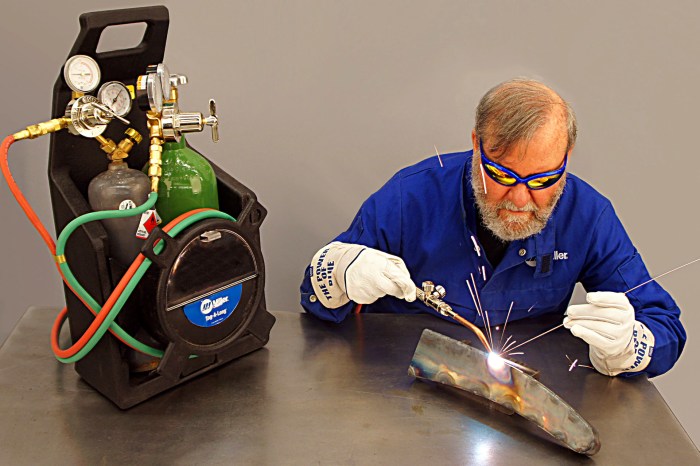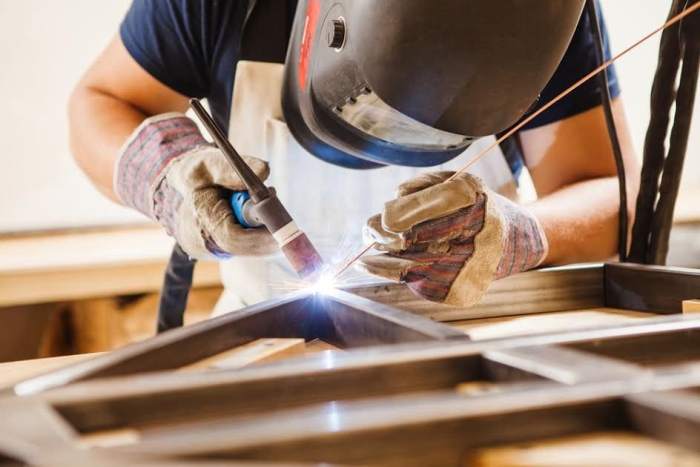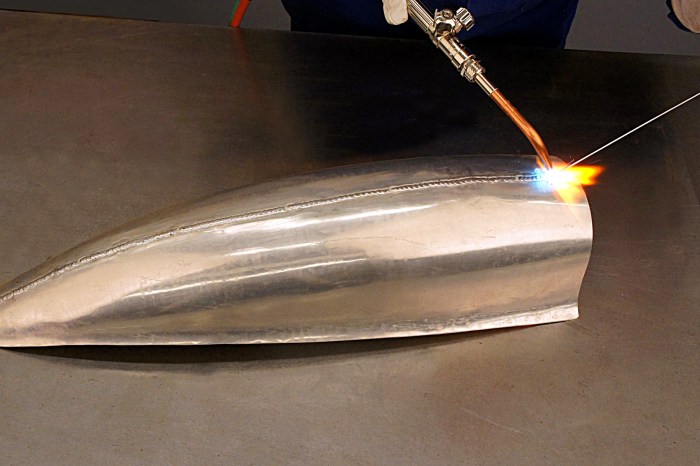Welding aluminum with oxy acetylene is a specialized technique that requires precision, safety, and an understanding of the unique properties of aluminum. This comprehensive guide will delve into the essential aspects of welding aluminum with oxy acetylene, empowering you with the knowledge and skills to achieve successful and high-quality welds.
From understanding the potential hazards and necessary safety precautions to mastering different welding techniques and troubleshooting common problems, this guide will provide a thorough foundation for both novice and experienced welders alike.
Safety Considerations
Welding aluminum with oxy acetylene requires adherence to strict safety measures due to potential hazards associated with the process.
Exposure to fumes, gases, and molten metal can pose health risks, while improper handling of equipment can lead to accidents.
Proper Ventilation
- Ensure adequate ventilation to prevent inhalation of toxic fumes and gases released during welding.
- Use local exhaust systems or respirators to minimize exposure to hazardous substances.
Protective Gear
- Wear appropriate protective gear, including fire-resistant clothing, gloves, safety glasses, and a welding helmet with a shade lens to protect against UV radiation and flying sparks.
- Use earplugs or earmuffs to minimize noise exposure.
Fire Prevention
- Keep a fire extinguisher nearby and ensure the work area is clear of flammable materials.
- Avoid welding in confined spaces or near combustible materials.
- Inspect equipment regularly for leaks or damage to prevent gas leaks and potential explosions.
Equipment and Materials
Oxy-acetylene welding of aluminum requires specialized equipment and materials to ensure a successful and safe welding process.
The essential components include:
Welding Torch
- The welding torch is the primary tool used to deliver the oxy-acetylene flame to the welding area.
- It consists of a handle, a mixing chamber, and a tip that controls the flame size and shape.
Gas Cylinders
- Oxygen and acetylene gas cylinders supply the gases required for the combustion process.
- Oxygen supports the combustion, while acetylene provides the fuel.
Filler Rods
- Filler rods are aluminum alloys used to fill the joint between the two pieces of metal being welded.
- They have a lower melting point than the base metal, allowing them to flow into the joint and create a strong bond.
Fluxes
- Fluxes are chemical compounds that are applied to the welding area to remove oxides and impurities.
- They improve the flow of the molten metal and prevent the formation of weak spots in the weld.
Welding Techniques
Welding aluminum with oxyacetylene involves various techniques, each with its advantages and disadvantages. Two primary methods are forehand and backhand welding.
Forehand Welding
In forehand welding, the torch is held in front of the welding puddle, with the flame directed towards the weld joint. This technique provides good visibility of the weld area, allowing for precise control over the weld pool. However, it can lead to overheating of the base metal and potential distortion.
Backhand Welding
Backhand welding involves holding the torch behind the welding puddle, with the flame directed away from the weld joint. This technique reduces the risk of overheating the base metal, but it can be more challenging to control the weld pool and maintain visibility.
Joint Preparation

Proper joint preparation is crucial for successful welding, ensuring a strong and durable bond between the aluminum pieces.
Joint preparation involves three main steps: cleaning, beveling, and fitting.
Cleaning
- Remove any dirt, grease, or oxidation from the joint surfaces using a wire brush or solvent cleaner.
- Cleaning ensures a clean surface for welding, promoting proper adhesion and preventing contamination.
Beveling
- For thicker aluminum pieces, beveling the edges of the joint creates a V-shaped groove.
- Beveling allows for better penetration of the weld metal and reduces the risk of cold laps or incomplete fusion.
Fitting, Welding aluminum with oxy acetylene
- Fit the aluminum pieces together tightly to ensure proper alignment and minimize gaps.
- Proper fitting prevents distortion and ensures a smooth, uniform weld.
Welding Parameters

When welding aluminum with oxy acetylene, several critical welding parameters must be considered to achieve optimal weld quality. These parameters include flame adjustment, torch angle, and travel speed.
Proper flame adjustment is crucial. An excessively oxidizing flame can cause aluminum oxide formation, leading to weld porosity and reduced strength. Conversely, a carburizing flame can result in brittle welds due to excessive carbon absorption. The ideal flame should be slightly reducing, with a luminous inner cone and a slightly feathered outer cone.
The torch angle also significantly impacts weld quality. Holding the torch at too steep an angle can result in undercut, while too shallow an angle can cause excessive weld bead reinforcement. The optimal torch angle for aluminum welding is typically between 45 and 60 degrees.
Travel speed is another critical parameter. Welding too quickly can result in incomplete fusion, while welding too slowly can lead to excessive heat input and weld distortion. The appropriate travel speed depends on the joint thickness, material thickness, and welding conditions.
Troubleshooting: Welding Aluminum With Oxy Acetylene

Welding aluminum with oxyacetylene requires precise techniques and careful attention to detail. However, certain common problems can arise during the welding process, hindering the quality and integrity of the weld.
To ensure successful aluminum welding, it is crucial to identify and address these issues promptly. This section will provide troubleshooting tips for resolving common problems encountered during oxyacetylene welding of aluminum.
Porosity
- Cause:Entrapped gas or moisture in the weld pool.
- Troubleshooting:
- Ensure proper joint preparation with clean, oxide-free surfaces.
- Use dry shielding gas to prevent moisture contamination.
- Adjust the welding flame to produce a slightly oxidizing flame.
Cold Laps
- Cause:Incomplete fusion between the weld metal and the base metal.
- Troubleshooting:
- Increase the welding heat input by adjusting the flame size or welding speed.
- Ensure proper joint preparation with clean, oxide-free surfaces.
- Use a fluxing agent to promote wetting and reduce surface tension.
Undercutting
- Cause:Excessive heat input or improper welding technique.
- Troubleshooting:
- Reduce the welding heat input by adjusting the flame size or welding speed.
- Maintain a proper welding angle and torch distance.
- Use a backing bar to support the weld joint and prevent excessive penetration.
Cracking
- Cause:Excessive heat input, improper joint design, or stress concentration.
- Troubleshooting:
- Reduce the welding heat input by adjusting the flame size or welding speed.
- Ensure proper joint design to minimize stress concentration.
- Use a preheating or post-heating technique to reduce thermal stresses.
Applications
Welding aluminum with oxy acetylene finds applications in various industries, owing to its versatility and cost-effectiveness. It is commonly employed in the following sectors:
- Automotive Industry:Fabrication of aluminum components for vehicles, such as engine blocks, transmission housings, and exhaust systems.
- Aerospace Industry:Construction of lightweight and durable aircraft structures, including wings, fuselages, and fuel tanks.
- Marine Industry:Welding aluminum hulls, decks, and superstructures of boats and ships.
- Construction Industry:Fabrication of aluminum window frames, doors, and curtain walls for buildings.
- Food and Beverage Industry:Production of aluminum containers, tanks, and piping for food and beverage processing.
The oxy acetylene welding process offers several benefits, including:
- Versatility:Can be used to weld a wide range of aluminum alloys and thicknesses.
- Portability:Equipment is relatively portable, allowing for on-site welding.
- Cost-effectiveness:Uses relatively inexpensive gases and equipment.
However, it also has limitations:
- Skill Requirement:Requires skilled welders to achieve high-quality welds.
- Safety Concerns:Involves open flames and high temperatures, necessitating proper safety precautions.
- Limited Penetration:May not be suitable for welding thick aluminum sections.
Questions and Answers
What are the potential hazards of welding aluminum with oxy acetylene?
Welding aluminum with oxy acetylene can generate toxic fumes, ultraviolet radiation, and sparks. Proper ventilation, respiratory protection, eye protection, and fire prevention measures are crucial to mitigate these hazards.
What are the essential equipment and materials needed for welding aluminum with oxy acetylene?
Essential equipment includes a welding torch, gas cylinders (oxygen and acetylene), filler rods, fluxes, safety gear, and proper ventilation. Fluxes are particularly important for aluminum welding, as they help dissolve the oxide layer that forms on the surface of aluminum.
What are the different welding techniques used for aluminum with oxy acetylene?
Common welding techniques include forehand welding, backhand welding, and puddle welding. Forehand welding is suitable for thin aluminum sheets, while backhand welding provides better penetration and is ideal for thicker materials. Puddle welding is used for filling gaps and creating a smooth weld bead.
What are the critical welding parameters for aluminum with oxy acetylene?
Critical welding parameters include flame adjustment, torch angle, and travel speed. The flame should be slightly carburizing to prevent oxidation of the weld pool. The torch angle should be held perpendicular to the joint, and the travel speed should be adjusted to maintain a stable weld pool and prevent overheating.
What are some common problems that may occur during welding aluminum with oxy acetylene?
Common problems include porosity, cold lap, and undercut. Porosity is caused by entrapped gas in the weld pool, while cold lap occurs when the weld metal does not properly fuse with the base metal. Undercut is a groove that forms along the edge of the weld bead due to excessive heat input.